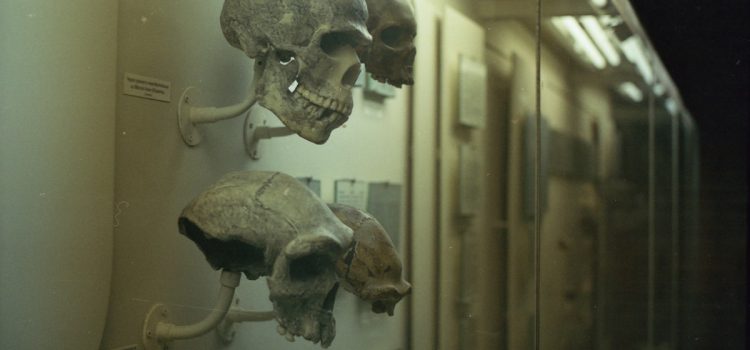

This article is an excerpt from the Shortform book guide to "A Short History of Nearly Everything" by Bill Bryson. Shortform has the world's best summaries and analyses of books you should be reading.
Like this article? Sign up for a free trial here.
How did human ancestors evolve from being ape-like to being human-like? Have scientists found fossils of a common ancestor of humans and apes?
Most scientists believe that the history of hominids includes Homo Erectus (first appearing about two million years ago) and Homo Sapiens (first appearing about 100,000 years ago). Bill Bryson explores this history in A Short History of Nearly Everything.
Keep reading for an overview of the history of hominids from Homo Erectus to Homo Sapiens.
A History of Hominids
According to Bryson, Darwinian scientists generally agree that humans and apes descended from a common ancestor that lived about seven million years ago. Since then, humans and apes have followed different evolutionary paths, although our ancestors remained very ape-like for several million years. The history of hominids starts about two million years ago with Homo Erectus.
(Shortform note: Scientists have yet to find fossils of this common ancestor. The closest relative they have found is “Ardipithecus,” a primate that lived about four million years ago. Studies of Ardipithecus suggest that our ancestors may not have been as ape-like as formerly thought. It appears that Ardipithecus had characteristics of both humans and apes, climbing through the trees like monkeys but walking upright on the ground like humans. If the common ancestor of humans and apes also had both these traits, perhaps each of the two branches perfected one and lost the other.)
Homo Erectus
Bryson says scientists think the transition from ape-like to human-like characteristics started with Homo Erectus about two million years ago. In addition to walking upright, Homo Erectus is thought to have built fires and cared for weak or injured members within a family or tribe, even though their intellectual abilities would only have been on par with a human baby. However, most of this is inferred from finds at a single dig site in Kenya, leading some scientists to question its validity.
(Shortform note: Scientists infer the intelligence level of Homo Erectus from the stone tools that they made: Their tools were simple enough that you could learn to make them just by imitating someone who was making them (much like babies learn by imitation) without any verbal instruction. These tools have now been found at multiple sites, as have remnants of their campfires. So only the inference that they cared for the injured is still based on a single fossil.)
Bryson notes that, around the same time (two million years ago), there was another branch of the evolutionary tree called the Australopithecines, which are thought to have walked upright but otherwise be mostly ape-like. He says this branch was once thought to be part of humans’ ancestral tree but is now regarded as an evolutionary dead-end.
(Shortform note: Some scientists believe that Homo Erectus evolved from Australopithecines, which would put them back in the lineage of humans. The fossil record is compatible both with the hypothesis that the Australopithecines were the ancestors of Homo Erectus and that they were a separate branch that died off. Fossil evidence indicates that Homo Erectus coexisted alongside Australopithecines for a time, but the oldest Australopithecus fossil that has been found is considerably older than the oldest Homo Erectus fossil.)
Homo Sapiens
Most scientists believe that the transition from Homo Erectus to Homo Sapiens occurred about 100,000 years ago. As Bryson explains, the first Homo Sapiens, or modern humans, are thought to have lived around that time, but there are differences of opinion about their lineage. Based on fossil evidence, scientists generally agree that Homo Erectus first appeared in Africa and spread all over the world. Some scientists think that Homo Sapiens also appeared first in Africa and spread out from there, displacing Homo Erectus. But other scientists think that Homo Erectus evolved into Homo Sapiens synchronously all over the world.
Neither hypothesis fits all the available data. Genetic studies (which compare DNA from different individuals and use the differences to determine how long ago they shared a common ancestor) tend to support the idea that all modern humans are descended from a small population that originated in northern Africa, perhaps as little as 25,000 years ago. But archeological studies tend to support the parallel evolution hypothesis because tools that the earliest Homo Sapiens developed in Africa don’t show up in places like East Asia—if humans had spread out from Africa, they would presumably have brought their stone-age technology with them.
| The Interbreeding Controversy The question of how much the different pre-human species (and animal species in general) interbred with each other over the course of their evolutionary history adds another dimension to the controversy over whether modern humans originated in Africa or evolved from Homo Erectus in multiple parts of the world. Traditionally, scientists thought hybridization between species played a negligible role in evolution because hybrid organisms are often unable to reproduce. But studies have also shown that when two different species do produce viable hybrid offspring, it sometimes produces a whole new species in just a few generations. This is because combining two genetic codes in a hybrid animal can produce a new and different code faster than the accumulation of mutations would. If new species evolve by hybridization as well as mutation, then their ancestral trees get more complicated. In the case of human origins, one hypothesis that hybridizes (no pun intended) the two competing theories is that after Homo Erectus spread over the world, a species called Homo Heidelbergensis also originated in Africa and spread over the globe, displacing Homo Erectus. Homo Heidelbergensis evolved into several different species, including Neanderthals and Denisovans. Finally, hybridization among these species gave rise to modern humans or at least contributed to their emergence in various parts of the world. But, as with other aspects of human origins, there is debate on the subject of hybridization. Some studies claim to have found strong evidence for hybridization between Neanderthals, Denisovans, and other ancient species in modern humans’ DNA. But other studies contend that this DNA evidence merely indicates a common ancestor, not interbreeding after the species diverged. |

———End of Preview———
Like what you just read? Read the rest of the world's best book summary and analysis of Bill Bryson's "A Short History of Nearly Everything" at Shortform.
Here's what you'll find in our full A Short History of Nearly Everything summary:
- An accessible overview of the natural sciences
- A full history of the universe, Earth, and life as we know it
- A look at the unknowns and controversies that still exist in the sciences






